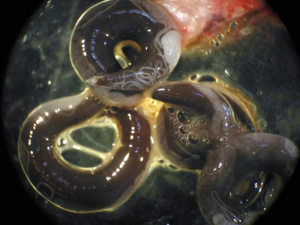
The Eel Swimbladder Nematode (Anguillicola crassus) is native to Japan and coastal China, where it is a widespread and common parasite of the Japanese Eel (Anguilla japonica). In the 1980s it was found in European Eel (Anguilla anguilla) in Germany, where it was likely transported with shipments of live Japanese Eels. From this early introduction and many secondary introductions, the parasite spread all across Europe. The parasite was first discovered in North America at an aquaculture facility in south Texas, but soon was seen in many other areas, from the Gulf Coast of Florida, to the St, Lawrence River and Lake Ontario. In the Chesapeake Bay, and other estuaries, ballast water is a likely vector for transport of this parasite because copepods, the nematode’s most frequent intermediate host, are frequently discharged with ballast water. Eels get the nematode by eating copepods and other crustaceans that have eaten the parasite. When the nematode larvae are eaten by the eel, they make their way to the eel’s swim bladder where they grow into reproducing adults. Adult nematodes release their larvae into the swim bladder. The larvae leave through the pneumatic duct into the water where they can again be eaten by copepods. American Eels (Anguilla rostrata) in many estuaries, have high infection rates, but given the eel’s migratory lifestyle, it’s difficult to know if this plays a role in their declining population. Since American Eels migrate to the Sargasso Sea, and spawn in deep water, damage to the swim bladder could affect their reproduction.